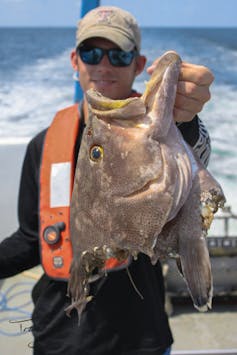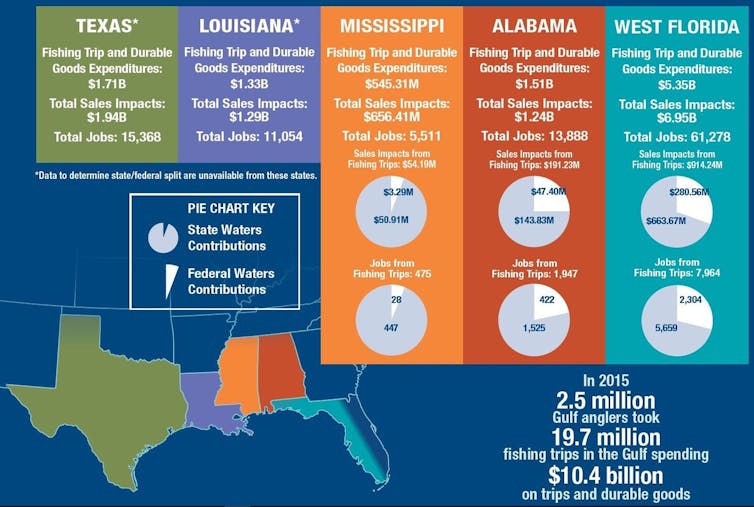
Fishermen across the Gulf of Mexico are reporting that something is eating fish off their lines. What’s to blame? Many recreational anglers point a finger at sharks.
This conflict has caught politicians’ attention. Congress has directed the National Oceanic and Atmospheric Administration, which regulates fishing in U.S. waters, to review shark and dolphin interactions with fisheries, and the U.S. House of Representatives recently passed the SHARKED Act, which would create a task force to address the problem.
I’ve studied this conflict, which is formally called depredation, for the past decade. While some shark populations in the Gulf of Mexico, such as bull sharks, are increasing, my colleagues and I have found evidence that human perceptions are also an important factor.
Sharky waters
The Gulf of Mexico is home to more than 70 species of sharks – and those are just the ones that scientists know about. The field of shark research has grown dramatically in recent decades, and new species are still being discovered.
For example, the American pocket shark, which is literally pocket-size, wasn’t discovered until 2019. This tiny shark lives in deep water far from shore and secretes a glowing blue fluid from small “pocket” glands near its front fins, for a purpose scientists have yet to determine.
Many other species, including bull sharks and sandbar sharks, are found in coastal waters. This creates the potential for conflict with anglers.
Shark predation on captured fish isn’t new. In Ernest Hemingway’s 1952 Pulitzer Prize-winning novella “The Old Man and the Sea,” an aging Cuban fisherman struggles to catch a giant marlin, only to see it eaten by sharks on his voyage home.

Hemingway himself contended with shark depredation as he attempted to land bluefin tuna in Bimini, the Bahamas. Kip Farrington, a longtime Field & Stream magazine editor and Hemingway confidante, noted that “none of these magnificent fish have ever been boated near Bimini unmarked by sharks.” Today, anglers often refer to sharks as “the tax man.”
Humans preying on sharks
Sharks have been harvested commercially in the Gulf since the 1930s. Catches increased during World War II, partly because shark livers were used in the production of Vitamin A, and declined after 1950 with the development of synthetic vitamins.
Shark catches surged again in the 1980s, encouraged by federal regulators, who saw sharks as an “underutilized resource.” Yet within a decade, scientists determined that several stocks of Gulf sharks were overfished, including sandbar sharks and dusky sharks.
In 1993, NOAA issued the first federal fishery management plan for sharks in U.S. waters of the Atlantic Ocean, including the Gulf of Mexico. These regulations created a pathway to rebuild stocks by requiring permits and establishing recreational trip limits and commercial catch quotas.
Today, many of the Gulf’s overfished shark stocks are recovering. As evidence grows that sharks are an important component of healthy oceans, this is a conservation success story. However, many anglers blame increases in depredation on regulations enacted to rebuild shark populations.
Shifting baselines
Experts agree that there are more sharks in the Gulf of Mexico today than there were 30 years ago. But how do these populations compare with levels before 1989, when commercial shark fishing spiked?
Over time, this question becomes increasingly difficult to answer as people gradually accept environmental decline. Marine biologist Daniel Pauly calls this habituation “shifting baseline syndrome.” For fisheries, each new generation of fishermen accepts the current, often reduced, status of a fish population as the baseline and forgets that there was a time when these species were much more abundant.
In this case, modern anglers are comparing increased numbers of sharks in the Gulf of Mexico to the past 30 years – a time when many shark populations were overfished.
Lifting baselines
The recovery of populations that were once overfished can create an opposite situation, known as lifting baselines, with conservation and management efforts leading to population increases.
Instances where populations have been overfished and then rebuilt can create a perception of overabundance. When the species that’s recovering is a predator, that can lead to human-wildlife conflict.
For example, recovering populations of California sea lions now compete with fishermen for their catch along the Pacific coast. Off Cape Cod, Massachusetts, the same thing happens with gray and harbor seals. The seals, in turn, are attracting white sharks.
The call to cull
Sportfishing is a popular and lucrative year-round industry across the Gulf of Mexico. As reports of depredation increase, so do calls for culling shark populations.
Similar action has been proposed elsewhere for other marine predators, including sea lions in California and goliath groupers in Florida.

Studies show, however, that predator removal is rarely an effective strategy. It’s particularly ineffective for species such as sharks that move around a lot and will readily recolonize areas that have been culled. Predator culls also pit people with different values, such as fishing boat operators and conservationists, against each other.
Paying the tax man
Unfortunately, there is no silver-bullet solution for shark depredation. The Gulf’s sportfishing industry has grown, and it’s likely that sharks learn to associate the presence of boats with an easy meal.
Shark deterrents are available, and new versions are continually being developed. Some fishermen are changing their practices to avoid sharks – for example, shifting locations frequently and never anchoring or fishing farther offshore to avoid coastal species such as bull sharks.
NOAA-funded research has identified sandbar sharks and bull sharks as the species that prey most often on catch. The agency is analyzing ways to better measure depredation and assess stocks of these two species to understand their population trends.
In my view, measures like these, along with better data about which sharks are taxing fishermen and where, are the most promising ways to help anglers coexist with sharks in the Gulf.![]()
James Marcus Drymon, Associate Extension Professor in Marine Fisheries Ecology, Mississippi State University
This article is republished from The Conversation under a Creative Commons license. Read the original article.


















